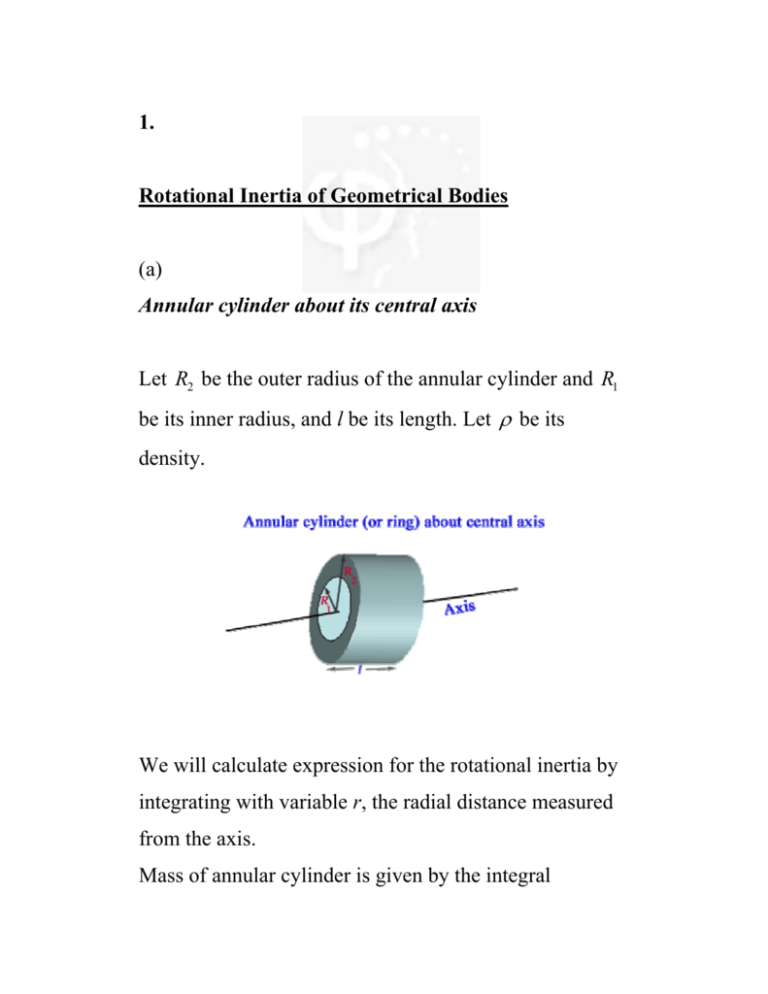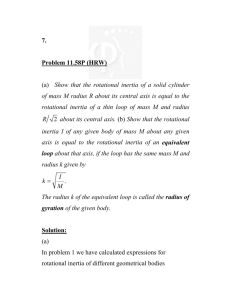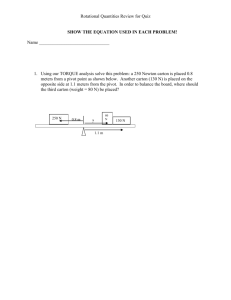1. Rotational Inertia of Geometrical Bodies (a
advertisement

1. Rotational Inertia of Geometrical Bodies (a) Annular cylinder about its central axis Let R2 be the outer radius of the annular cylinder and R1 be its inner radius, and l be its length. Let ! be its density. We will calculate expression for the rotational inertia by integrating with variable r, the radial distance measured from the axis. Mass of annular cylinder is given by the integral R2 % 2" rl ! dr M# R1 # " l ! ( R2 2 $ R12 ). Its rotational inertia is given by the integral I# R2 % 2" rl ! dr & r 2 , R 1 = 12 " l ! ') R2 4 $ R14 (* I annular cylinder # 1 M ( R2 2 + R12 ). 2 (b) Solid cylinder (or ring) about central axis Let the radius of the cylinder be R and its mass M. We can obtain its rotational inertia I from the formula for the rotational inertia of an annular cylinder by substituting R1 # 0 and R2 # R. We have I solid cylinder # 1 MR 2 . 2 (c) Solid disk of width ,h Let R be the radius, ,h thickness and ! be the density of the disk. For calculating the rotational inertia about the axis as shown in the figure we choose angular variable measured from the vertical direction, and consider an infinitesimal box of length dx, height dy and width ,h . The moment of inertia can be found by integrating R R sin - 0 0 I # 4 % dy % ! ,h x 2 dx. As y # R sin - , dy # $ R cos- d- . Therefore, " 2 I # 4& R sin - % R sin - d- % 0 4 # ,h! R 4 3 # # 0 " 2 % sin 4 - d- , 0 4 3" ,h! R 4 & , 3 16 " 4 x 2 ,h! dx, & ! R 4 ,h. But the mass of the disk is R M # % 2" r ,h! dr 0 # " R 2 ,h! . Thus the moment of inertia of a thin disk of mass M is I thin disk # 1 MR 2 . 4 We will use the parallel axis theorem for finding the rotational inertia of a thin disk about an axis parallel to the vertical axis passing through its centre. This gives I O # I CM + Mh 2 . Using the expression of rotational inertia of a thin disk, we have I O thin disk # " 4 ! R 4 ,h + " R 2 ! ,h h 2 . (d) Cylinder about axis through its CM We will use this result for calculating the rotational inertia of a solid cylinder of length L, radius R, and mass M about a vertical axis passing through its centre of mass. L 2 L 2 '1 ( 4 2 2 I # 2 . & ! R " % dh + ! R " % h dh / 0 0 ). 4 */ # 1 1 & ! R 4" L + & ! R 2" L3 . 4 12 Mass of the cylinder M is M # " R 2 L! . We thus find that the rotational inertia of a cylinder about axis as shown in the figure is I cyl # 1 1 & MR 2 + ML2 . 4 12 (e) Thin rod about an axis through its centre Rotational inertia of a thin rod of length L and mass M about an axis passing through its centre can be obtained from the above result by putting in it R =0. We get I thinrod # 1 ML2 . 12 (f) Thin rod about axis at one of its ends By applying parallel axis theorem and using the expression of rotational inertia of a thin rod about axis through its CM, we get 1 & ML2 + M ( L ) 2 , 2 12 1 # & ML2 . 3 I thinrod $ axis at end # (g) Thin spherical shell about any diameter Let radius of the shell be r, its thickness ,r and ! be its density. Using spherical polar coordinates and measuring distance from the polar axis, we have " 2" 0 0 I thin spherical shell # % d- 2 ! , r r sin - d2 0 r sin - 1 , % 2 " # ! ,r r & 2" & % sin 3 - d- , 4 0 # 8" & ! ,r r 4 . 3 Mass of a spherical shell of radius r, thickness ,r and density ! is M # 4" r 2 ,r ! . Using this expression for M, the rotational inertia of a thin spherical shell of radius r can be expressed as I thin spherical shell # 2 & Mr 2 . 3 (h) Rotational inertia of a solid sphere With this result we obtain next the rotational inertia of a solid sphere of radius R about any diameter. Integrating the thin spherical shell expression with respect to r from 0 to R, we get I sphere 8" # & ! % r 4 dr , 3 0 I sphere 8" R 5 # . 15 R Mass of a homogeneous sphere of radius R and density ! is 4" R 3 M# . 3 We thus find I sphere # 2 MR 2 . 5 (i) Rotational inertia of a thin slab Let the length of the slab be a, its width be b, its thickness be ,c and its density be ! . Its rotational inertia about an axis perpendicular to its plane and passing through its centre of mass can be calculated by integrating the following expression; a 2 I # ,c ! % b2 dx $a 2 # % 0x 2 + y 2 1 dy, $b 2 ,c ! ab 2 a + b2 1. 0 12 Mass of the slab is M # ,c ! ab. We thus find I thin slab # 1 M (a 2 + b 2 ). 12







